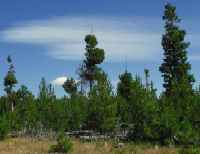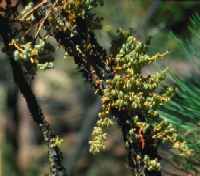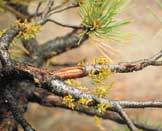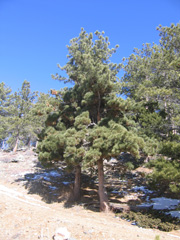by R.D. Koski, W.R. Jacobi and C.E. Swift * (12/13)
Quick Facts…
- Mistletoes are parasitic flowering plants that can infect and damage many tree species.
- Dwarf mistletoes (Arceuthobium spp.) are leafless parasitic plants that infect several coniferous or evergreen tree species in many western states.
- Ponderosa, lodgepole, limber, and pinyon pines and Douglas-fir are the most common trees affected by dwarf mistletoes in Colorado.
- Juniper mistletoe (Phoradendron juniperinum) is another type of mistletoe that can infect several juniper species in many western states.

Figure 1: Lodgepole pine infected with dwarf mistletoe display witches’ brooms and dead branches. |

Figure 2: Witches’ brooms – dense, multiple branches on lodgepole pine infected with dwarf mistletoe. |
Dwarf mistletoes (Arceuthobium species) are leafless parasitic plants that infect several species of conifers in Colorado forests. Dwarf mistletoes produce root-like structures that grow in the living tissue just under the bark (phloem) and in the wood (xylem), where they extract both nutrients and water from their host plants. Germinating seeds of mistletoes produce specialized structures called holdfasts that allow newly emerged parasitic plants to penetrate the tissues of host plants, thus infecting the host plant.
There are five species of dwarf mistletoes that infect conifers in Colorado (Table 1). While some dwarf mistletoes are relatively host-specific and generally do not infect other tree species, other species infect a wide range of coniferous tree species (Table 1). In addition, juniper mistletoe (Phoradendron juniperinum) is also present in Colorado and is a different type of mistletoe that is less damaging compared to dwarf mistletoes, in that it primarily acquires only water from the host tree. Juniper mistletoe is found in western Colorado and can infect several juniper species (Juniperus species) in many western states (Table 1).
The dwarf mistletoes and juniper mistletoe are dioecious plants, meaning male flowers and female flowers are produced on separate plants. The flowers produced by these mistletoes are small and inconspicuous.
Symptoms and Signs
When viewed from a distance, coniferous trees infected with dwarf mistletoes may appear to have yellow foliage, reduced foliage, abnormally dense green and distorted foliage or witches’ brooms, and mortality of the upper portion of the affected tree (Figures 1, 2, and 3).
Closer examination of branches of affected trees will reveal the yellowish green, olive green, or reddish brown segmented shoots of the parasitic plant (Figures 4 and 5).
The first symptom of dwarf mistletoe infection is a slight swelling of the bark at the infection site. The parasite is identifiable when shoots protrude two to three years after infection. Dwarf mistletoe shoots are 0.7 to 15 cm (1/2 to 6 inches) long and 2-4mm in diameter (Figures 4 and 5). Douglas-fir dwarf mistletoe shoots are hard to see because they are only about 7 mm (1/2 inch) long. When shoots have fallen off, look for the remnants of basal cups on branches.
After initial infection, mistletoes can cause distorted branching or witches’ brooms in the host tree (Figure 2). When dwarf mistletoes infect occasional hosts – hosts other than the primary host – different and unique symptoms may occur. For example, lodgepole pine dwarf mistletoe causes very large and dense witches’ brooms when it infects ponderosa pine (Figure 7). Lodgepole pine dwarf mistletoe also induces on limber pine, large elongate galls with rarely any shoots present.
Juniper mistletoe plants are usually seen as large yellowish-green round masses of small branches in the crown of junipers (Figure 6). Juniper mistletoe does not induce the juniper to make witches’ brooms.
Table 1. Mistletoes of Colorado conifers.
| Common names | Mistletoe species | Common name of host | Host plant species | Description |
| Lodgepole pine dwarf mistletoe |
Arceuthobium americanum | Lodgepole pine ponderosa pine, whitebark pine, bristlecone pine, limber pine, mugo or mountain pine, Scots or Scotch pine, Engelmann spruce, blue spruce, subalpine fir |
Primary Host: Pinus contorta var. latifolia Occasional hosts: Pinus ponderosa var. scopulorum, Pinus albicaulis, Pinus aristata, Pinus flexilis, Pinus mugo, Pinus sylvestris, Picea engelmanii, Picea pungens, Abies lasiocarpa |
Shoots are yellowish to olive green, mean shoot height 5-9 cm, with whorl-like branching; fruit is an ovoid berry, olive green and 3.5-4.5 mm long and 1.5-2.5 mm wide |
| Limber pine dwarf mistletoe |
Arceuthobium cyanocarpum | Limber pine whitebark pine, bristlecone pine, lodgepole pine, ponderosa pine, southwestern white pine |
Primary Host: Pinus flexilis Occasional hosts: Pinus albicaulis, Pinus aristata, Pinus contorta var. latifolia, Pinus ponderosa, Pinus strobiformis |
Shoots are yellowish green, mean shoot height 3 cm, with fan-like branching; fruit is a bluish (cyan)-ovoid berry and 3.5 mm long and 2.0 mm wide |
| Pinyon dwarf mistletoe |
Arceuthobium divaricatum | Pinyon pine | Primary Host: Pinus edulis | Shoots are olive green to brown, mean shoot height 8 cm, with fan-like branching; fruit is an ovoid berry, green/white and 3.5 mm long and 2.0 mm wide |
| Douglas-fir dwarf mistletoe |
Arceuthobium douglasii | Douglas-fir white fir, subalpine fir, Engelmann spruce, blue spruce |
Primary Host: Pseudotsuga menzeisii Occasional Hosts: Abies concolor, Abies lasiocarpa, Picea engelmannii, Picea pungens |
Shoots are olive green, mean shoot height 2 cm, with fan-like branching, fruit is an ovoid berry, olive green/white, and 3.5-4.5 mm long and 1.5-2.0 mm wide |
| Southwest dwarf mistletoe |
Arceuthobium vaginatum subsp. cryptopodum | Ponderosa pine | Primary Host: Pinus ponderosa Occasional Host: Pinus aristata, Pinus contorta var. latifolia, Pinus flexilis, Pinus strobiformis, Pinus sylvestris |
Shoots are orange to reddish brown (sometimes very dark brown), mean shoot height 10 cm, with extensive branching; fruit is an ovoid berry, bi-colored, and 4.5-5.5 mm long and 2.0-3.0 mm wide |
| Juniper mistletoe |
Phoradendron juniperinum | Rocky Mountain juniper, Utah juniper, oneseed juniper | Primary Hosts: Juniperus scopulorum, Juniperus osteosperma, Juniperus monosperma | Shoots are green to yellow green, leafless, mean shoot height 20-40 cm; plants globose, with extensive branching; fruit is an ovoid berry, pinkish-white, and 4 mm in diameter |

Figure 3: Lodgepole pine with dead top and dense dwarf mistletoe-induced brooms on the lower stem. |

Figure 4: Ponderosa pine dwarf mistletoe plants. |

Figure 5: Lodgepole pine dwarf mistletoe plants. Note thin green-yellow shoots. |

Figure 6: Juniper mistletoe. Note the globose growth in this juniper. |

Figure 7: Dense dark green brooms on ponderosa pine infected with lodgepole pine dwarf mistletoe. |
Damage to Host Trees
Dwarf mistletoe witches’ brooms extract nutrients from uninfected parts of the tree, gradually reducing host tree vigor and eventually causing premature death. Dwarf mistletoe infested trees decline and die from the top down as witches’ brooms on lower branches extract more nutrients and water (Figures 1 and 3). Death of the host tree occurs slowly in most cases and depends on the severity of infection and on the vigor and size of the tree.
A measure of dwarf mistletoe infection severity is based on a two-part rating system (Tables 2a and 2b). First, a tree’s crown is divided into thirds, and each third is rated. If there are no visible infections, that third of the crown is rated 0; if 1 to 50 percent of the branches are infected in that third, the rating is 1; and if more than 50 percent of the branches are infected, the rating is 2 (Table 2a). Add the ratings of each third to get a total dwarf mistletoe rating (Table 2b). Life expectancy information for trees afflicted with dwarf mistletoe is provided in Table 3.
Table 2a. Rating scale for dwarf mistletoe infection severity.
| Percent of Tree Crown Section Infected with Dwarf Mistletoe1 | Tree Crown Section Rating |
| 0 | 0 |
| 1-50 | 1 |
| 51-100 | 2 |
| 1 Top third, middle third, and bottom third of tree. | |
Table 2b. Dwarf mistletoe rating system (DMR).
| Rating1 | Infection Severity |
| 2-3 | Light |
| 4-5 | Moderate |
| 6 | Heavy |
| 1 Sum of rating of top third, middle third, and bottom third of tree. | |
Table 3: Approximate number of years needed to kill 50 percent of Ponderosa pine trees infected with dwarf mistletoe.1
| Tree Diameter | Infection Severity2 | ||
| Light | Moderate | Heavy | |
| 4-9 inches | 30 | 17 | 7 |
| Greater than 9 inches | 60 | 25 | 10 |
| 1Based on ponderosa pine in open, multi-aged stands.2Infection severity based on the following:light = a rating of 2 or 3; moderate = a rating of 4 or 5; heavy = a rating of 6. | |||
Witches’ brooms develop over many years. Dwarf mistletoe witches’ brooms extract nutrients and water from uninfected parts of the tree, gradually reducing host tree vigor and eventually causing premature death. Junipers infested with juniper mistletoe will have clusters of the yellowish green parasitic plant growing amongst the juniper foliage (Figure 6).
Juniper mistletoe witches’ brooms extract primarily water from the host plant. On heavily infested trees, the parasite can cause death of portions of the tree during prolonged periods of below normal precipitation.
Spread
Dwarf mistletoes spread slowly from tree to tree. In closely spaced trees of about the same height, this spread is 0.3 to 0.6 m per year. The spread from large to small trees can extend 19 m (60 ft), but the average usually is less than 9 m.
The sticky seeds of Arceuthobium species are explosively discharged from the fruit at almost 60 miles per hour, adhering to any surface they strike. Seeds that adhere to young branches of susceptible trees germinate, and the mistletoe rootlet penetrates the bark. Dwarf mistletoe seeds generally are dispersed in August and early September. Birds and other animals can occasionally spread the seeds some distance to uninfected trees. Dwarf mistletoes have a relatively long life cycle between infection and seed production (six to eight years). The long life cycle allows for long-term disease management. Mistletoes are not common in nursery and ornamental plantings, but the parasites can be introduced into an area by planting trees unknowingly infected with mistletoe. Dwarf mistletoes can greatly impact the forest structure and appearance. Areas of expanding numbers of infected trees can be found in the forest where the center of the area or “donut hole” has no large trees left since they were infected years ago and died, and there might be some heavily infected understory trees in the center and a ring of heavily infected trees at the margin.
The fruits and seeds of Phoradendron juniperinum are spread by birds and consequently can be spread a great distance in a single season. A number of bird species feed on the juniper mistletoe fruits and disperse the seeds by excreting or regurgitating them. Seeds are deposited on the top side of branches of juniper hosts. Germinating seeds produce a holdfast that penetrates the host plant.
Management
Mistletoes cause a gradual decline of plant health and do not quickly cause serious injury, thus long-term management options are feasible. However, mistletoe-infected trees may become sufficiently stressed as to attract mountain pine bark beetle (MPBB), Ips bark beetles, and twig beetles that may breed and kill parts (twig and Ips) of or the whole tree (MPBB, Ips). Mistletoe management options include branch pruning, tree removal, and planting resistant tree species.
Management Options:1. Pruning and removing trees is the best management measure available to reduce or eliminate dwarf mistletoe infestations in ornamental trees or urban forests. 2. Plant resistant trees under infected trees to replace trees when infected ones are removed. 3. Use ethephon sprays in high-value areas where planting with the same species under infected trees is the only option. |
Branch Pruning and Tree Removal
Pruning out the witches’ brooms and removing infected trees is the best management measure available to reduce or eliminate dwarf mistletoe infestations in stands of high-value trees. First, remove severely infected trees (trees rated 5 and 6) or those with only a few live branches. Trees with high, unreachable mistletoe infections will continue to shower seeds on nearby trees if not cut down. However, it is not necessary to completely eradicate the mistletoe, as this may require removal of all trees. Pruning infected branches and removal of a few heavily infected trees can keep a green forest on the property.
Pruning off the lower and the largest witches’ brooms from lightly to moderately infected trees (trees rated 1 to 4) can improve the health and allow these trees to survive for decades. When removing a witches’ broom, prune the entire branch at the branch collar near the trunk. Examine trees every two or three years, and remove any newly infected branches. When pruning, keep 30 percent to 40 percent of the branches on the tree (from the top down), even if that means leaving some infected branches. Mistletoe shoots die as soon as the tree branch is cut, so no special disposal of pruning debris is needed. Trunk infections are not as detrimental as branch infections, so their removal is not necessary. If space allows, create 18 m buffer zones between infected trees and healthy trees by cutting or by planting resistant trees. Contact a professional forester, the Colorado State Forest Service, or other professionals to obtain help in these decisions.
Plant Resistant Tree Species
Planting resistant or non-host tree species in areas with infected trees will ensure that trees will be in the area even after the infected trees are removed (Table 4).
Table 4. Recommended species to replant in mistletoe affected areas.
| Mistletoe-infected Species | Recommended Species |
| ponderosa pine | white fir (Abies concolor), blue spruce (Picea pungens), bristlecone pine (Pinus aristata), pinon pine (Pinus edulis), limber pine (Pinus flexilis), Douglas-fir (Pseudotsuga menziesii), and/or Rocky Mountain juniper (Juniperus scopulorum) |
| lodgepole pine | subalpine fir (Abies lasiocarpa), Engelmann Spruce (Picea engelmannii), bristlecone pine, limber pine and/or Douglas-fir |
| Douglas-fir | Engelmann spruce, lodgepole pine, and/or ponderosa pine |
| juniper | Ponderosa pine and/or pinyon pine |
NOTE: Scotch or Scots pine (Pinus sylvestris) is susceptible to both southwest and lodgepole pine dwarf mistletoes.
Deciduous trees and shrubs, such as birch, peashrub, ash, aspen, cottonwoods, and Gambel oak also can be planted in affected areas because dwarf and juniper mistletoe do not attack these plants. Keep in mind that site conditions and moisture availability will determine what trees and shrubs can be planted in a particular area.
Chemical Sprays
Ethephon (2-chloroethanephosphonic acid) is a growth regulating chemical that can be used to remove mistletoe shoots and reduce seed production. Ethephon is usually only used in high value areas where young trees should be protected until infected overstory trees are removed. This treatment does not kill the entire mistletoe plant, just the shoot. Retreatment is necessary until infected trees are removed, mistletoe infections are pruned from the tree, or new non-host trees are planted.
Additional Information
Colorado Master Gardener Garden Notes (available from the Colorado Master Gardener Program website, https://cmg.extension.colostate.edu/volunteer-information/cmg-gardennotes-class-handouts/
- GardenNotes #617, Pruning Evergreens
- GardenNotes #633, The Science of Planting Trees
Fact Sheets (available from the CSU Extension website)
- Fact Sheet 5.558, Ips Beetles
- Fact Sheet 5.528, Mountain Pine Beetle
- Geils, B.W., Tovar, J.C., and Moody, B. 2002. Mistletoes of North American Conifers. Gen. Tech. Rep. RMRS-GTR-98. Ogden, UT: USDA, Forest Service, Rocky Mountain Research Station. 123p.
*R.D. Koski, Colorado State University research associate, horticulture and landscape architecture; W.R. Jacobi, professor, bioagricultural sciences and pest management; C.E. Swift, retired Extension horticulture agent, Tri-River Area, Grand Junction.2/99. Revised 12/13.
Go to top of this page.





